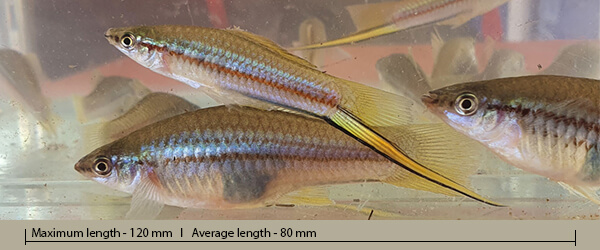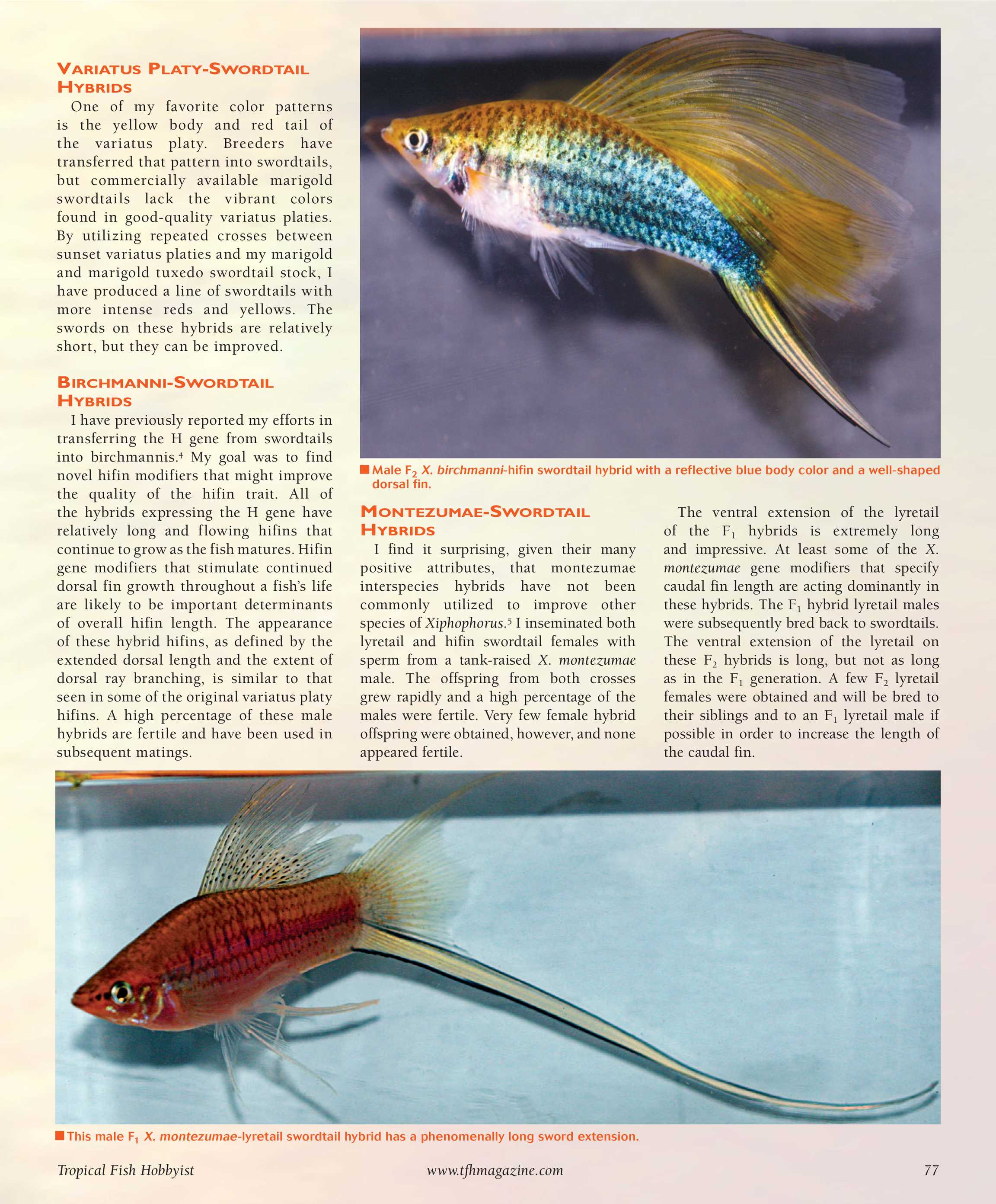Swordtail fish often suffer from fin rot and ich. These common health problems require prompt treatment and proper tank maintenance.
Swordtail fish are popular among aquarium enthusiasts due to their vibrant colors and hardy nature. Despite their resilience, they can still face various health issues. Fin rot is one such problem, typically caused by bacterial infections due to poor water quality.
Ich, another common ailment, manifests as white spots on the fish’s body and fins. Regular water changes, proper filtration, and a balanced diet can help prevent these issues. Early detection and treatment are crucial for maintaining the health of your swordtail fish. By providing a clean and stable environment, you can ensure your swordtails thrive.
Introduction To Swordtail Fish
Swordtail fish are popular in home aquariums. Their vibrant colors and active behavior make them a favorite. They are relatively easy to care for, but understanding their needs is crucial.
Origins And Habitat
Swordtail fish, known as Xiphophorus hellerii, originate from Central America. They are native to freshwaters in Belize, Guatemala, and Mexico.
They thrive in streams, rivers, and ponds with slow-moving water. These habitats provide ample vegetation and hiding spots. In aquariums, mimic their natural environment for best results.
Physical Characteristics
Swordtail fish get their name from the sword-like extension on males’ tails. This feature makes them easy to identify.
They come in various colors, including red, green, and black. Their vibrant hues make them stand out in any aquarium.
Females are generally larger than males. Males have the distinctive sword on their tails. Swordtail fish grow up to 6 inches in length.
Providing a balanced diet and clean water is essential for their health. Regular monitoring can prevent common health problems.

Credit: rivers.dwer.wa.gov.au
Signs Of A Healthy Swordtail
Ensuring your Swordtail fish is healthy is essential for their well-being. Recognizing the signs of a healthy Swordtail can help you provide the best care. Here are some key indicators to look for:
Active Behavior
A healthy Swordtail is always active. They swim around the tank energetically. You will see them exploring their surroundings. They interact with other fish in the tank.
- Swimming actively throughout the tank.
- Responding to feeding times.
- Displaying playful behavior with tank mates.
Bright Colors
Bright colors are a sign of a healthy Swordtail. They should have vibrant and consistent colors. Faded or dull colors can indicate health issues.
| Healthy Swordtail | Unhealthy Swordtail |
|---|---|
| Vibrant colors | Faded colors |
| Consistent color patterns | Patchy or discolored spots |
Bright colors show good health and happiness. Ensure your Swordtail has a balanced diet and clean water.
Common Health Issues
Swordtails are beautiful and hardy fish. But they are not immune to health problems. Here are some common health issues that Swordtails may face.
Ichthyophthirius (ich)
Ichthyophthirius, commonly known as Ich, is a parasitic disease. It causes white spots on the fish’s body and fins. These spots look like grains of salt. Fish infected with Ich may scratch against objects. They may also breathe rapidly. Ich can be treated with over-the-counter medications. Keep the tank clean to prevent Ich.
Fin Rot
Fin Rot is another common issue. It causes the fins to look ragged and torn. Fin Rot is usually caused by poor water quality. Bacteria or fungi infect the damaged fins. Affected fish may also show signs of lethargy. Improving water quality can help. Use antibiotics to treat bacterial infections. Antifungal treatments are needed for fungal infections.
| Health Issue | Symptoms | Treatment |
|---|---|---|
| Ichthyophthirius (Ich) | White spots, scratching, rapid breathing | Over-the-counter medications, clean tank |
| Fin Rot | Ragged fins, lethargy | Improve water quality, antibiotics, antifungal treatments |
Parasites And Infections
Swordtail fish are beautiful pets. But they can suffer from parasites and infections. These health problems can make your fish sick. Understanding these issues can help you keep your fish healthy.
External Parasites
External parasites live on the outside of the fish. They can cause itching and sores. Some common external parasites include:
- Ich: Small white spots on the fish’s body.
- Gill Flukes: Worms that attach to the gills.
- Anchor Worms: Worms that look like threads hanging from the fish.
To treat external parasites:
- Quarantine the sick fish.
- Use anti-parasitic medications.
- Clean the tank regularly.
Internal Parasites
Internal parasites live inside the fish’s body. They can cause weight loss and a swollen belly. Common internal parasites are:
- Tapeworms: Long, flat worms that live in the intestines.
- Roundworms: Thin, round worms that also live in the intestines.
- Protozoa: Tiny organisms that can cause severe illness.
To treat internal parasites:
- Isolate the infected fish.
- Use anti-parasitic food or medication.
- Maintain proper hygiene in the tank.
| Parasite Type | Symptoms | Treatment |
|---|---|---|
| Ich | White spots | Anti-parasitic medication |
| Gill Flukes | Red gills | Anti-parasitic medication |
| Anchor Worms | Threads on skin | Manual removal, medication |
| Tapeworms | Weight loss | Anti-parasitic food |
| Roundworms | Swollen belly | Anti-parasitic food |
| Protozoa | Severe illness | Medication |
Water Quality Problems
Maintaining good water quality is crucial for the health of your swordtails. Poor water conditions can lead to several health issues, affecting their well-being. Let’s explore two common water quality problems: Ammonia Poisoning and pH Imbalance.
Ammonia Poisoning
Ammonia is a toxic chemical found in fish tanks. It comes from fish waste, uneaten food, and decaying plants. High levels of ammonia can be deadly for swordtails.
Symptoms of ammonia poisoning include:
- Gasping for air at the surface
- Red or inflamed gills
- Loss of appetite
- Lethargy
To prevent ammonia poisoning, keep the tank clean. Use a reliable filter and perform regular water changes. Test the water frequently to ensure ammonia levels are safe.
Ph Imbalance
pH measures the acidity or alkalinity of the water. Swordtails need a pH level between 7.0 and 8.4. An imbalance can cause stress and health problems.
Signs of pH imbalance include:
- Unusual swimming behavior
- Color changes
- Clamped fins
- Stress symptoms
To maintain proper pH levels:
- Test the water regularly using a pH test kit.
- Use pH stabilizers if needed.
- Avoid overfeeding and remove uneaten food.
- Include natural elements like driftwood or rocks to stabilize pH.
By monitoring these factors, you can ensure a healthy environment for your swordtails.
Nutritional Deficiencies
Ensuring your swordtail fish gets a balanced diet is crucial. Nutritional deficiencies can lead to severe health problems. This section will guide you on recognizing malnutrition and providing a balanced diet.
Signs Of Malnutrition
Malnutrition in swordtail fish presents through various symptoms. Watch for these signs:
- Dull Colors: Lack of nutrients affects their vibrant colors.
- Lethargy: Malnourished fish often appear inactive and tired.
- Weight Loss: Rapid weight loss can indicate poor nutrition.
- Reduced Appetite: A malnourished fish may eat less or refuse food.
- Fin Rot: Poor diet can lead to fin rot and other infections.
Balanced Diet Tips
A balanced diet helps maintain swordtail fish health. Here are some tips:
- Variety: Offer a mix of high-quality flakes, pellets, and live foods.
- Vegetables: Include blanched spinach or peas for fiber and vitamins.
- Protein: Feed them brine shrimp or bloodworms for protein.
- Frequency: Feed small amounts twice a day to prevent overfeeding.
- Supplements: Use vitamin supplements if needed for a nutrient boost.
Providing a balanced diet prevents nutritional deficiencies. It ensures your swordtail fish remain healthy and vibrant.
Preventive Measures
Preventing health problems in Swordtails is crucial for their well-being. Following some preventive measures can help maintain a healthy environment for your fish. Let’s dive into some essential steps you can take.
Regular Tank Maintenance
Regular tank maintenance is vital for keeping your Swordtails healthy. Clean the tank weekly to remove waste and uneaten food. Ensure the water is clear and free of harmful bacteria. Test the water quality regularly using water test kits. Maintain the pH level between 7.0 and 8.3.
Changing 25% of the tank water every week helps keep the environment clean. Use a gravel vacuum to clean the substrate. This will help remove debris and waste. Clean the filter every month to ensure it functions properly.
Here’s a quick checklist for regular tank maintenance:
- Clean tank weekly
- Test water quality
- Change 25% of water weekly
- Vacuum substrate
- Clean filter monthly
Quarantine Procedures
Quarantining new fish is essential to prevent diseases. Use a separate tank for new arrivals. Keep them in quarantine for at least two weeks. This helps detect any signs of illness before introducing them to the main tank.
Observe the new fish daily for any symptoms. Look for signs like white spots, unusual behavior, or loss of appetite. Treat any detected illness in the quarantine tank to avoid spreading it.
Here’s a simple quarantine checklist:
- Set up a separate quarantine tank
- Quarantine new fish for two weeks
- Observe for signs of illness
- Treat detected illnesses

Credit: www.tfhdigital.com
Treatment Options
Swordtails are beautiful fish but can face health issues. Knowing the right treatment options is essential. This section will guide you through effective methods to keep your swordtails healthy.
Medications And Remedies
Fish medications are a common way to treat swordtail health problems. Anti-parasitic medications can help with parasites. Antibiotics are useful for bacterial infections.
You can also use natural remedies. Salt baths are good for treating skin issues. Add aquarium salt to the water. This helps kill harmful bacteria and parasites.
Here is a table of common medications and their uses:
| Medication | Purpose |
|---|---|
| Anti-parasitic | Treats parasites |
| Antibiotics | Treats bacterial infections |
| Aquarium Salt | Treats skin issues |
Professional Help
Sometimes, home remedies are not enough. You may need professional help. A veterinarian can diagnose the problem accurately. They can prescribe the right medications and treatments.
Here are steps to take when seeking professional help:
- Observe your fish closely.
- Note any unusual behavior or signs.
- Contact a fish veterinarian.
- Follow the vet’s instructions carefully.
Professional help ensures your swordtail gets the best care possible.

Credit: www.amazon.com
Frequently Asked Questions
What Is The Lifespan Of A Swordtail Fish?
Swordtail fish typically live for 3 to 5 years. Proper care and a healthy environment can extend their lifespan. Maintain clean water, balanced diet, and suitable tank conditions for longevity.
What Is The Skinny Disease In Swordtails?
The skinny disease in swordtails is a parasitic infection. It causes weight loss and lethargy in affected fish. Treatment includes anti-parasitic medications and improved tank hygiene.
How Often Should I Feed Swordtails?
Feed swordtails 2-3 times daily in small amounts. Ensure all food is consumed within 2-3 minutes. Avoid overfeeding.
What Does A Pregnant Swordtail Look Like?
A pregnant swordtail has a rounded, swollen belly and a dark gravid spot near her rear fin. She may also exhibit slower movements.
Conclusion
Maintaining swordtail health requires attention to water quality, diet, and disease prevention. Regular check-ups and proper care can ensure their well-being. By understanding common health issues, you can keep your swordtails thriving. Happy and healthy swordtails contribute to a vibrant aquarium.
Always prioritize their needs for a beautiful, lively tank.
